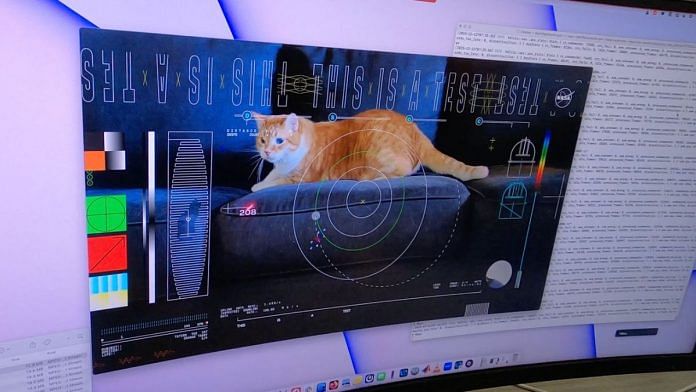New Delhi: Most of us are guilty of occasionally browsing through cute cat videos during office hours, but when scientists at NASA’s Jet Propulsion Laboratory (JPL) in Southern California watched a live-streamed clip of a ginger tabby chasing a laser dot — they created history.
The 15-second clip of a cat named Taters — the pet of a JPL employee — sent on 11 December, has become the first ultra-high definition streaming video beamed from space.
The video was transmitted as part of NASA’s Deep Space Optical Communications (DSOC) experiment, from a spacecraft 31 million kilometres away — about 80 times the Earth-Moon distance. It took 101 seconds to reach Earth, where it was received by a telescope at the Palomar Observatory in California.
The milestone is part of a NASA technology demonstration aimed at streaming very high-bandwidth video and other data from deep space, enabling future human missions beyond Earth’s orbit, including ‘the next giant leap’ — sending humans to Mars.
We just streamed the first ultra-HD video brought to you via laser from deep space. And it’s a video of Taters, a tabby cat.
This test will pave the way for high-data-rate communications in support of the next giant leap: sending humans to Mars. https://t.co/tf2hWxaHWO pic.twitter.com/c1FwybYsxA
— NASA (@NASA) December 19, 2023
The experiment, which was launched with NASA’s Psyche mission on 13 October, is designed to transmit data from deep space at rates 10-100 times greater than the radio frequency systems currently used by deep space missions.
As Psyche travels to the main asteroid belt between Mars and Jupiter, the technology demonstration will send high-data-rate signals as far out as the Red Planet’s greatest distance from Earth, which could be a maximum of 401 million kilometres.
“This accomplishment underscores our commitment to advancing optical communications as a key element to meeting our future data transmission needs,” said Pam Melroy, NASA deputy administrator, in a statement Monday.
“Increasing our bandwidth is essential to achieving our future exploration and science goals, and we look forward to the continued advancement of this technology and the transformation of how we communicate during future interplanetary missions,” Melroy added.
How was video transmitted?
The demo transmitted the 15-second test video via an instrument called a flight laser transceiver.
The video is overlayed with graphics, which illustrate several features from the tech demo, such as Psyche’s orbital path, Palomar’s telescope dome, and technical information about the laser and its data bit rate. Tater’s heart rate, colour, and breed are also on display.
“One of the goals is to demonstrate the ability to transmit broadband video across millions of miles. Nothing on Psyche generates video data, so we usually send packets of randomly generated test data,” Bill Klipstein, the tech demo’s project manager at JPL, said in a statement Monday.
“But to make this significant event more memorable, we decided to work with designers at JPL to create a fun video, which captures the essence of the demo as part of the Psyche mission,” he added.
(Edited by Richa Mishra)
Also Read: Cosmic treasure! NASA’s asteroid sample that’s landed on Earth could hold clues to origin of life




boss it cannot be 31 million km in 101 seconds. That would be faster than the speed of light. Please learn math. It is 30.4 million miles. Here is the NPR link to with details https://www.npr.org/2023/12/19/1220539948/this-cat-video-is-out-of-this-world-and-nasa-used-a-laser-to-beam-it-to-earth#:~:text=The%2015%2Dsecond%20video%20was,of%20267%20megabits%20per%20second.